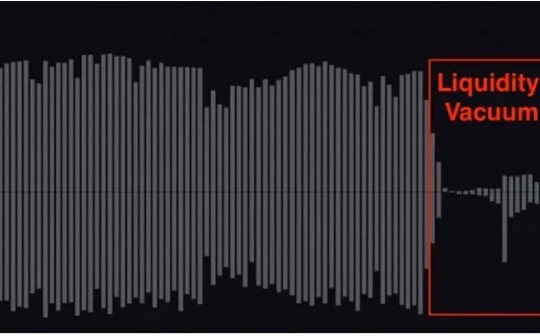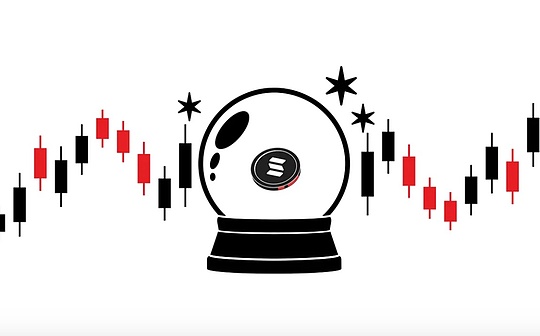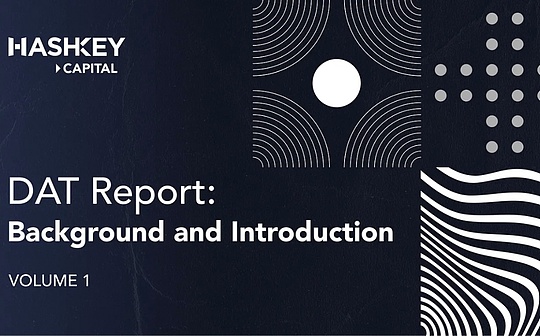
On September 3, Etherealize, which calls itself “the institutional-grade product, BD, and market arm of the Ethereum ecosystem,” disclosed $40 million in financing. In addition to the investment led by Electric Capital and Paradigm, what is more noteworthy is the direct participation of Ethereum co-founder Vitalik Buterin and the Ethereum Foundation.
To a certain extent, this investment symbolizes the Ethereum community’s firm support for a professional and institutional development path. In fact, it also sends a clear signal thatThe growth logic of Ethereum is shifting from “capacity expansion” to the spillover and integration of the “application layer”.
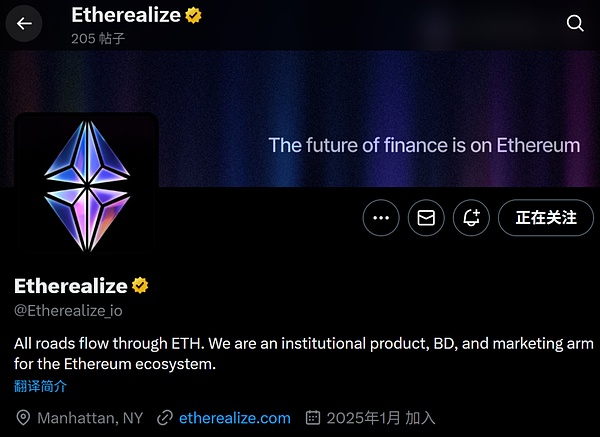
If you look back, you will find that from the DeFi wave in 2020-2021, to the subsequent CeDeFi practice, and now the accelerated integration into TradFi – Ethereum’s way of innovating traditional finance is constantly “survival of the fittest”.
The development of Ethereum is moving from the “infrastructure construction period” to the “application explosion and ecological reshaping period”, and the trillion-dollar “second curve” is taking shape.
01After capacity expansion, a new growth engine is switching
As we all know, the main theme of Ethereum’s development has always been “scaling”.
With the maturity of L2 Rollup solutions such as Arbitrum and Optimism in recent years, and the gradual advancement or implementation of basic protocols such as Danksharding and EIP-4844, Ethereum’s basic computing power and throughput have been significantly improved, especially the L2 ecosystem has established a solid “execution layer” foundation.
It can be said that after several years of exploration, Ethereum has initially solved the problem of “can it be used”, but what is more difficult is to answer the next question – who will it be used by, and how will it be used?
After all, the challenges facing Ethereum have never been as severe as they are now:
-
On the one hand, high-performance public chains such as Solana and Sui are eroding the on-chain market with their “faster and cheaper” positioning;
-
On the other hand, traditional Web2 giants such as Visa, Stripe, Paypal, Robinhood and even Fidelity are also launching self-developed public chains or integrated decentralized clearing and settlement systems to improve their Crypto/TradFi layout;
Looking back on the past five years, at the application level, Ethereum is undoubtedly a hotbed of innovation and almost the best “combinable on-chain financial laboratory”. From DeFi and NFT to DAO, GameFi, and SocialFi, it has supported the entire wave of Web3 experiments.
However, the innovation at this stage is mainly aimed at native Web3 users, and is essentially still limited to the “self-circulation of capital on the chain.”in other words,Funds flow on the chain and protocols are stacked on the chain, but real-world assets, institutions and users always remain in the observation seat.
Web3 is logically self-consistent, but it is difficult to connect with the needs of the real financial world.In such a competitive landscape, Ethereum’s “technological leadership” is no longer a moat. To continue to grow, it must answer another more ambitious question: How to break through the boundaries of Web3 itself and become a true underlying settlement layer for global assets?
The new increment is coming from outside Web3 – the computing power demand of AI and the settlement demand of traditional finance, pushing it into a new cycle at the same time:
The most typical example is the wave of tokenization of RWA (real world assets) – traditional financial institutions such as banks, securities firms, and fund companies are actively trying to move assets such as bonds, stocks, and fund shares onto the blockchain to achieve on-chain clearing and real-time settlement.
At the same time, as the monopoly of AI models and data intensifies, the AI industry is eager for a neutral and credible settlement layer to solve core pain points, including model and data verification, decentralized computing verification, and resistance to centralization risks. In short, AI requires a global verifiable computing layer to price trust, and the blockchain itself naturally adapts to this need of AI.
Of course, to support demands such as TradFi and AI, Ethereum must be fully upgraded in terms of performance, privacy, and modularity.
02New roadmap: multi-pronged progress of zkVM, AI, and privacy
In order to respond to these new demands, the Ethereum community and foundation are already promoting several key strategies. The following are the current routes that are more public and discussed by the industry.
The first is zkVM (zero-knowledge virtual machine). This is not only a technical extension of L2 expansion, but also a disruptive reshaping of the functions of the Ethereum main network. For example, the Ethereum Foundation is currently promoting the main network-level zkVM architecture, which replaces repeated execution of transaction verification with zero-knowledge proof (ZKP), thus greatly improving throughput and security.
The core logic of zkVM is to transform the trust model, because traditional Ethereum relies on all nodes to re-execute transactions to reach consensus, and the biggest advantage of zkVM is that the verification node will no longer replay all transactions, but only needs to verify the proof (Proof), significantly reducing synchronization and execution costs.
Under this new architecture, the Ethereum mainnet is expected to completely become the “computing settlement layer”, focusing on verifying ZK proofs and anchoring the final state, while L2 becomes an efficient “execution layer”, completely evolving Ethereum from a blockchain into a global verifiable computing layer.
Vitalik Buterin just last month retweeted and praised the minimal zkVM proposed by Ethereum developers for lean Ethereum: Optimized for XMSS aggregation and recursion, leanVM minimizes commitment costs compared to Cairo with a four-instruction ISA, multi-linear STARK and logup lookups.
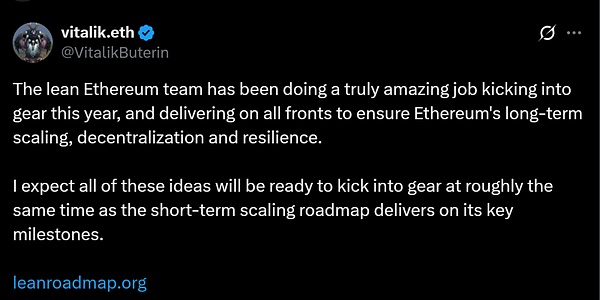
Another clear signal is that on September 15, the Ethereum Foundation established the artificial intelligence team “dAI”, dedicated to building a decentralized AI ecosystem. This also marks that Ethereum is no longer just passively “used by AI”, but actively “integrated with AI.”
The core task of the dAI team is to invest resources in defining the standards, incentives and governance structures of AI models on the blockchain, including model credibility: how to ensure the transparency of AI model training data, how to use ZK technology to prove the integrity of model reasoning, and the formulation of new standards – for example, in order to better serve the AI ecosystem, the community is promoting new standards such as ERC-8004 and x402:
-
ERC-8004: aims to establish a “composable and accessible” decentralized AI infrastructure layer that allows developers to easily build and integrate AI model services;
-
x402: Committed to defining a unified on-chain payment and settlement standard to ensure that users can make efficient, atomic-level micropayments when accessing AI models, storing data, or using decentralized computing services on the chain;
Through these efforts, Ethereum is trying to define the underlying protocol and settlement mechanism of decentralized AI, positioning itself as the “value clearing and trust layer of decentralized AI.”
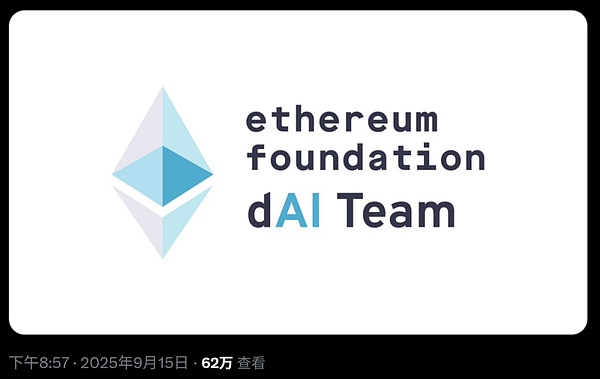
In addition, in order to meet the trillions of assets in TradFi, Ethereum must solve the contradiction of privacy and compliance, and its privacy roadmap has begun to be layered to meet the needs of different groups.
Among them, institutional privacy and compliance (the core appeal of TradFi) focuses on exploring compliant privacy solutions on L2/L3, which means that institutions can conduct encrypted transactions and clearing on the chain, and at the same time provide auditable and verifiable transaction records to specific regulatory parties (such as auditors, regulatory agencies) through zero-knowledge proof or authority control mechanisms, protecting business secrets while meeting regulatory requirements.
Personal privacy (Web3 user protection) uses account abstraction (AA) and privacy enhancement technology (such as private transactions) on L2 to solve the problem of MEV (Miner Extractable Value) attacks and leakage of personal transaction data from the protocol layer to ensure that users’ on-chain behavior is protected.
These three routes——Universality (zkVM), application boundaries (dAI/new standards) and compliance (privacy)——Together, they constitute Ethereum’s “Second Curve” core strategy for AI and TradFi needs.
03What if the “second curve” transition is successful?
asFrom the DeFi wave in 2020-2021, to the subsequent CeDeFi practice, and the latest big step to proactively integrate into TradFi, Ethereum’s way of innovating global finance has been “survival of the fittest”.
Therefore, the current “super evolution” of Ethereum is not easy, but once the transition is successful, its ecology and status will be completely reshaped.
First of all, Ethereum will be upgraded from an “application platform” for Web3 native users to a “computing power & financial infrastructure platform” for global mainstream economies. Its position in the global financial system will be more solid, becoming the de facto “global value settlement layer.”
Following this, more and more high-value businesses (such as institutional-level RWA, AI model verification, decentralized data market) will choose to be deployed directly on Ethereum or its zk-native structure, forming a huge liquidity pool and trust guarantee.
Then the L2/Rollups ecosystem will evolve into a “collaborative network”. They are no longer independent “independent public chains”, but are more deeply connected with the zk layer of the main network, focusing on providing different execution environments (EVM, ZKVM, privacy customization, etc.). Eventually, sub-ecologies such as underlying stablecoins, privacy protocols, data oracles, and AI model markets are expected to take advantage of the trend and provide necessary “middleware” for institutions and AI.
Overall, the emerging “second curve” of Ethereum marks its leap from a “cryptocurrency computing layer” to a “global trust and settlement layer” – no longer just a paradise for speculators, but a rapid transformation into an indispensable financial primitive in the global economic infrastructure.
After all, the AI industry needs its trustworthy neutrality, and traditional finance needs its efficient compliance. ZKVM, AI team and privacy roadmap are the combined punches of Ethereum to meet these two trillion-dollar needs.
Please believe that the best times are yet to come.

